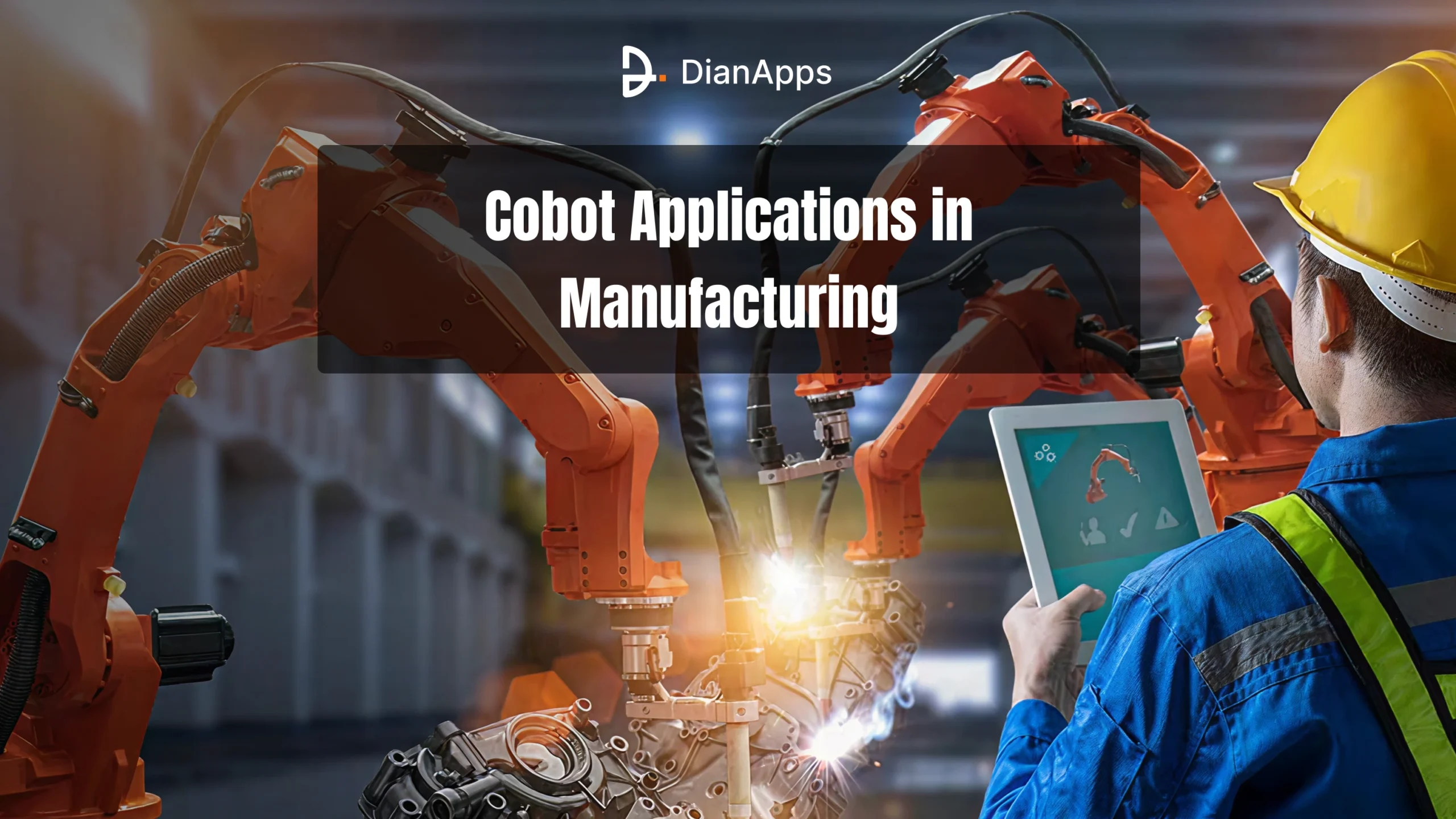10 Revolutionary Cobot Applications in Manufacturing: Real-World Use Cases & Benefits
What if the future of manufacturing wasn’t about humans or robots, but about both working together seamlessly? That’s exactly what cobots in manufacturing (collaborative robots) are delivering today.
Unlike traditional industrial robots that often work behind cages, cobots are designed to collaborate safely with human workers. They’re transforming everything from assembly lines to material handling while boosting efficiency, safety, and flexibility.
So, how do cobots work in manufacturing? In simple terms, cobots use advanced sensors, AI-driven programming, and lightweight designs to share workspaces with humans without risk. This means manufacturers can achieve higher throughput, reduce errors, and adapt quickly to demand fluctuations, all without massive infrastructure overhauls.
In this blog, we’ll explore the top 10 cobot applications in manufacturing, backed with real-world use cases, benefits, and insights into how these smart machines are redefining Industry 4.0.
Why Cobots Are Reshaping Manufacturing
The growing adoption of cobots in manufacturing isn’t just about automation; it’s about transforming how humans and machines work together. By combining efficiency with safety and adaptability, cobots are setting a new standard for Industry 4.0 factories.
Flexibility in Operations
Unlike traditional industrial robots, cobots are designed to be versatile and reprogrammable. Manufacturers can deploy them for tasks like assembly, inspection, or packaging and easily switch between roles as production demands change. This agility allows companies to respond faster to shifting market needs without heavy investment in new systems.
Enhanced Safety for Workers
Built with advanced sensors and force-limiting technology, cobots can detect human presence and automatically pause or slow down to avoid accidents. This makes them safe to work alongside humans on the factory floor, fostering true collaboration rather than isolation.
Boosting Productivity and Human Value
Cobots handle repetitive, labor-intensive tasks while employees focus on problem-solving, creativity, and supervision. This synergy doesn’t just speed up production; it increases accuracy and improves worker satisfaction.
Cost-Efficiency and ROI
Cobots require less setup time, consume less energy, and reduce errors, leading to faster returns on investment compared to traditional robots.
Scalability for Smart Manufacturing
As factories embrace Industry 4.0, cobots can be seamlessly integrated with IoT and AI systems, making them future-ready investments.
According to IFR, collaborative robot installations in manufacturing are projected to grow by over 20% annually, proving their vital role in reshaping modern production lines.
Top Cobot Applications in Manufacturing
Assembly Line Operations
Cobots make assembly lines faster and safer by handling repetitive fastening, screwing, and component fitting tasks. At Ford’s Cologne plant, cobots assist workers in engine assembly by tightening bolts and attaching parts with consistent torque. This reduced errors, improved worker ergonomics, and increased daily output. The flexibility of cobots also allows Ford to quickly reconfigure processes for new car models, minimizing downtime and accelerating time-to-market.
Material Handling Applications
Cobots streamline material handling tasks like loading, unloading, and transporting parts. BMW’s Regensburg factory deploys cobots to move car doors and components across workstations, significantly lowering worker strain and accident risks. By integrating vision systems, the cobots can identify and pick irregular objects, making them suitable for both small-batch and large-scale operations. This implementation has enhanced productivity while maintaining a safe, collaborative working environment.
Quality Inspection
With high-resolution cameras and AI-driven sensors, cobots can detect defects that humans often miss. At Continental Automotive Systems, cobots inspect brake systems and electronic parts for precision. This has reduced error rates by 20% and decreased production waste. Workers, freed from tedious inspection tasks, now focus on resolving detected issues and optimizing processes, proving how cobots complement human expertise rather than replacing it.
Packaging and Palletizing
End-of-line packaging is a labor-heavy process. Unilever’s food processing plants use cobots for case packing and palletizing, ensuring consistent stacking and reducing repetitive strain injuries. Cobots automatically adapt to different box sizes and seasonal demand surges. This not only improved efficiency by 15% but also enhanced workplace safety. Employees now supervise and optimize workflows instead of doing monotonous lifting, creating a more engaged workforce.
Welding Support
Welding is hazardous and requires precision. General Motors (GM) integrates cobots into its welding stations to handle spot and arc welding. These cobots maintain uniform quality, reduce exposure to heat and fumes, and support skilled welders with heavy workloads. GM reported improved weld consistency and reduced downtime, while workers focused on higher-level tasks like programming and process improvements. This combination of safety and efficiency made cobot welding highly impactful.
Machine Tending
Cobots shine in loading and unloading CNC machines. Whirlpool Corporation uses cobots in its appliance manufacturing plants to feed materials into CNC machines and retrieve finished parts. This has cut cycle times and reduced bottlenecks, leading to higher machine utilization rates. Skilled machinists now dedicate time to process optimization, rather than repetitive loading tasks. The cobot integration boosted efficiency without increasing labor costs.
Surface Finishing
Tasks like sanding, polishing, and deburring require consistency. Airbus employs cobots for surface finishing on aircraft fuselages, ensuring smooth, uniform results. Workers previously struggled with repetitive fatigue in these tasks, but cobots now handle large-area sanding, improving accuracy and reducing physical strain. Airbus reported faster turnaround times in aircraft production, demonstrating how cobots maintain precision while enhancing worker well-being.
Electronics Manufacturing
The electronics industry demands delicate precision. Foxconn integrates cobots for smartphone and circuit board assembly, where accuracy down to microns is required. Cobots place tiny components reliably while humans supervise quality and troubleshoot. This integration not only improved yield rates but also enabled flexible adaptation to frequent product changes. Cobots helped Foxconn cut production errors and boost output in one of the world’s most competitive industries.
Injection Molding
Removing hot, freshly molded parts is dangerous and time-sensitive. Sepro Group integrates cobots with injection molding machines to extract and stack plastic components. This reduced worker exposure to heat while cutting cycle times. A U.S. plastics manufacturer reported a 30% increase in throughput after adopting cobot-assisted molding. The cobots also improved workplace safety, reducing accidents related to manual part removal.
Medical Device Manufacturing
In the medical sector, cobots handle delicate, regulatory-compliant tasks. Medtronic employs cobots for assembling catheters and stents, ensuring consistent precision. By reducing variability, cobots help maintain compliance with strict quality standards. Workers focus on oversight and testing, while cobots ensure repeatability in high-volume production. Medtronic saw a measurable reduction in defects and faster production cycles, proving cobots’ critical role in life-saving device manufacturing.
According to IFR, over 30% of new industrial robot installations by 2027 are expected to be cobots, proving their growing role across diverse manufacturing sectors. To build these applications, you definitely need to hire AI developers who can help businesses build an intuitive software.
Benefits of Manufacturing Cobots
The rise of cobots in manufacturing is not just about automation; it’s about redefining efficiency, safety, and scalability in the modern factory. By blending human creativity with robotic precision, cobots are creating a new model of smart production that goes beyond traditional robotics.
Improved Safety on the Shop Floor
Cobots are designed with built-in sensors, force-limiting features, and collision-detection systems. Unlike traditional robots that must be caged, cobots work side by side with people, automatically pausing when human presence is detected. This reduces workplace injuries and makes factories safer without slowing down operations.
Higher Productivity and Efficiency
By taking over repetitive and time-consuming tasks, cobots allow human workers to focus on supervision, creativity, and problem-solving. This balance boosts output and reduces downtime. For example, in automotive plants, cobots significantly increase assembly speed while maintaining accuracy.
Cost Savings and ROI
Cobots are more affordable than traditional robots, both in purchase price and setup. They require less specialized programming and minimal floor redesign. Many businesses see ROI within 12–18 months, making cobots a smart investment for small and mid-sized manufacturers.
Scalability and Flexibility
Unlike rigid industrial robots, cobots can be redeployed to different tasks within hours. Manufacturers can quickly adapt to changing product lines, seasonal surges, or new market demands, ensuring agility without major infrastructure changes.
Better Job Satisfaction for Employees
Cobots take on repetitive, labor-intensive tasks, freeing employees to focus on high-value activities. This not only enhances job satisfaction but also reduces fatigue and turnover rates, fostering a healthier workplace culture.
A report from MarketsandMarkets shows that the cobot market is expected to reach $9.2 billion by 2028, driven by these benefits across industries.
Cobots vs Traditional Robots
When exploring cobot applications in manufacturing, it’s important to understand how they compare with traditional industrial robots. Both play crucial roles, but their functionality and value differ significantly depending on the use case.
| Feature | Cobots | Traditional Robots |
|---|---|---|
| Safety | Built-in sensors and force limits allow safe collaboration with humans. | Require safety cages and restricted zones to prevent accidents. |
| Flexibility | Easily reprogrammed and redeployed for multiple tasks. | Task-specific, with complex reprogramming and setup needed. |
| Cost & ROI | Lower upfront cost; ROI within 1–1.5 years. | Higher investment; ROI can take several years. |
| Setup & Space | Compact design, minimal floor redesign. | Large footprint, requires major infrastructure changes. |
| Human Involvement | Complements workers by handling repetitive tasks. | Designed to replace human roles in full automation setups. |
| Industry Fit | Ideal for SMEs and industries needing adaptability. | Best suited for high-volume, fixed production environments. |
In short, cobots emphasize human-robot collaboration, agility, and affordability, whereas traditional robots dominate where speed and full automation are prioritized.
How to Implement Cobots in Manufacturing
Implementing cobot applications in manufacturing requires more than just purchasing a robot—it involves strategy, training, and integration with existing workflows. A structured approach ensures smooth adoption and faster ROI.
- Assess Business Needs: Start by identifying processes that are repetitive, labor-intensive, or prone to errors. For example, machine tending or packaging are quick wins where cobots deliver immediate benefits.
- Select the Right Cobots: Choose cobots based on payload capacity, reach, and precision. Manufacturers like Universal Robots and FANUC offer cobots tailored for assembly, material handling, or inspection tasks.
- Pilot Projects Before Scaling: Begin with small pilot programs to test workflows and evaluate ROI. Many companies start with one or two cobots and expand deployment once results prove positive.
- Employee Training and Collaboration: Training workers to work with cobots is essential. Instead of job displacement, employees are upskilled to supervise, program, and optimize cobots, thereby building a culture of collaboration.
- Integration with Industry 4.0 Systems: Connect cobots with IoT platforms, AI-driven quality control, and factory automation systems. This transforms them into smart, data-driven assets that optimize production lines.
A PwC study found that manufacturers who strategically integrate cobots can achieve productivity improvements of up to 30% within the first year of deployment.
Recommended Read: Mobile App Development for Manufacturing Industry: Usage, Types and Key Benefits
Challenges in Cobot Integration (and Solutions)
While the benefits of manufacturing cobots are compelling, businesses often face hurdles during implementation. Addressing these challenges early ensures smoother adoption.
- High Initial Investment: Even though cobots are cheaper than traditional robots, upfront costs can still feel high for SMEs. Solution: Start with small-scale deployments in high-ROI areas and expand gradually.
- Employee Resistance to Change: Workers may fear job loss or distrust new technology. Solution: Emphasize cobots as assistants, not replacements, and provide reskilling programs that prepare employees for higher-value roles.
- Integration Complexity: Cobots must work with existing machinery, which can be challenging in older factories. Solution: Use middleware and vendor support to ensure compatibility with legacy systems.
- Safety and Compliance Concerns: While cobots are designed for safe collaboration, regulatory compliance varies across regions. Solution: Follow ISO standards (like ISO/TS 15066) to ensure safe human-robot collaboration.
- Scaling Across Multiple Sites: What works in one facility may not scale easily. Solution: Standardize deployment practices and create a central team to oversee multi-site integration.
According to McKinsey, companies that address workforce and integration challenges upfront are 2.5x more likely to achieve sustainable cobot ROI compared to those that don’t.
Future of Collaborative Robots in Manufacturing
The future of cobot applications in manufacturing looks brighter than ever, driven by rapid advancements in AI, IoT, and machine learning. As factories embrace smart manufacturing and Industry 4.0, cobots will evolve from simple assistants to intelligent collaborators that can analyze data, learn tasks, and adapt in real-time.
Cobots will also become more affordable, making them accessible to small and mid-sized enterprises that previously relied only on manual labor. With 5G-enabled connectivity, cobots will integrate seamlessly with connected factory ecosystems, improving visibility, predictive maintenance, and real-time quality control. Moreover, as sustainability becomes a global priority, cobots will help reduce waste, optimize energy usage, and enable greener manufacturing practices.
According to ABI Research, the global cobot market is projected to surpass $24 billion by 2030, with adoption spreading beyond automotive and electronics into food processing, pharmaceuticals, and even small-scale production facilities.
Final Words
The adoption of collaborative robots in manufacturing is no longer a futuristic concept; it’s a present-day reality reshaping how industries operate. From assembly lines to quality inspections and material handling, cobots are delivering measurable improvements in safety, efficiency, and worker satisfaction.
By embracing cobots, manufacturers are not just automating processes; they are building agile, human-centric factories ready for the demands of Industry 4.0. Whether you are an SME looking for flexibility or a global enterprise pursuing scale, cobots provide the perfect bridge between human ingenuity and robotic precision. So, today, even custom software development companies like DianApps are also utilizing cobots to make the process easier.
The future belongs to manufacturers who can balance human skills with robotic capabilities, and cobots are at the heart of this transformation.




